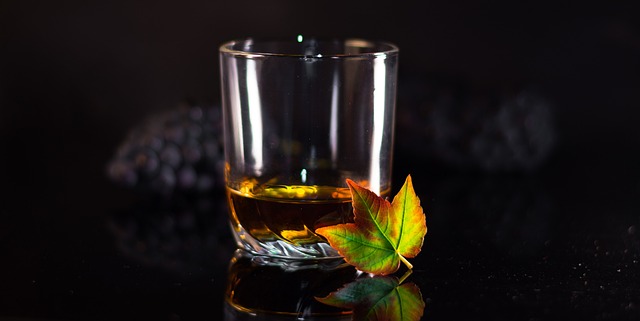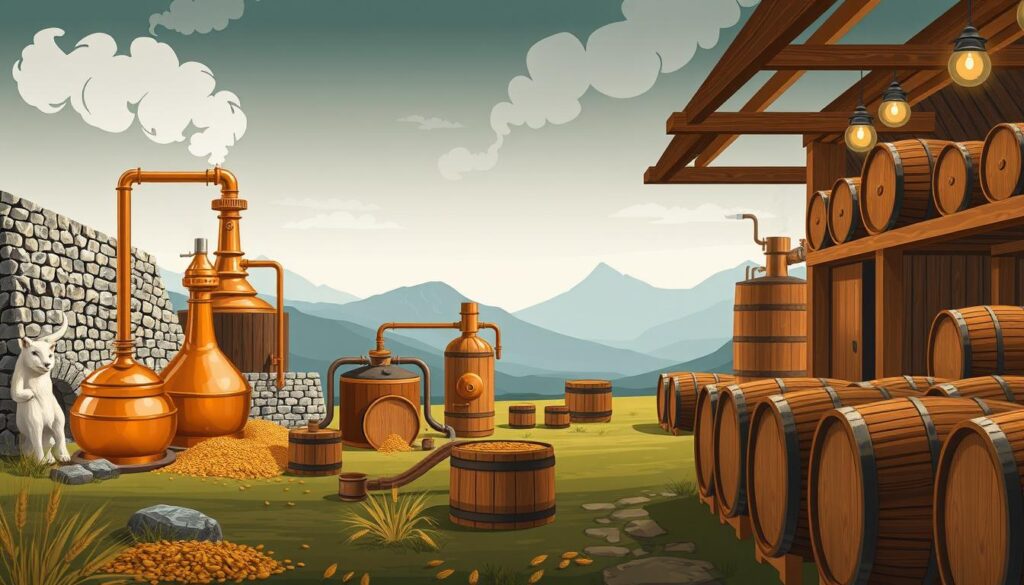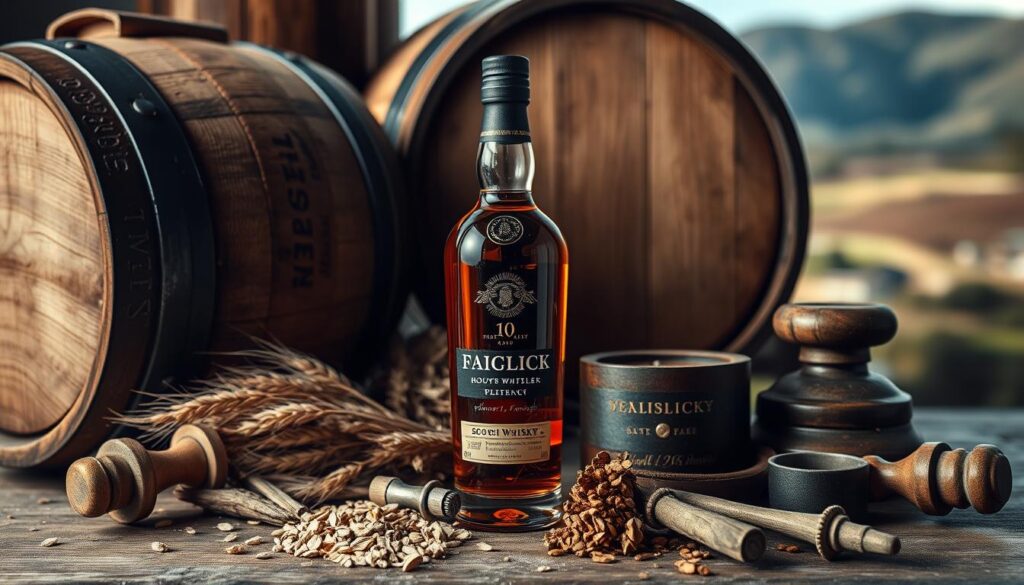The world of spirits shows interesting differences between whisky and scotch. The spelling itself tells a story. “Whisky” is a term used in Scotland, Canada, and Japan. On the other hand, people use “whiskey” in Ireland and the United States.
When comparing whisky and scotch, remember a key fact: Scotch has a special status. It must originate entirely in Scotland, age for at least three years in oak barrels, and contain a minimum of 40% alcohol.
Scotch is unique because of its strict rules. The Scotch Whisky Association has enforced these since 1912. The five regions – Speyside, Highland, Islay, Lowland, and Campbeltown – each add special flavors to Scotland’s spirit.
Speyside is the heart of Scotch production, with over half of Scotland’s distilleries. Single malt Scotch is from pure malted barley. This makes it different from other whiskies, like Japanese ones, which are triple-distilled for extra smoothness.
Want to uncover more about Scotch and whiskey? Keep reading!
Understanding Basic Terminology and Origins
The tale of scotch whisky begins in Scotland in the 15th century. It comes from ‘uisge beatha,’ meaning ‘water of life’ in Gaelic. Over time, this term became ‘whisky’ in Scottish speech. The craft of whisky spread across Scotland’s highlands and islands, leading to different styles.
Single malt scotch is a true reflection of Scottish distilling. It uses malted barley, water, and yeast. Each distillery adds its own touch, thanks to local water and climate. The magic happens in copper pot stills, where distillers control temperature and timing.
Today, Scotch whisky must meet strict rules to earn the name scotch. It must age in oak barrels in Scotland for at least three years. This aging process adds rich flavors and golden colors. Interestingly, blenders sell 80% of scotch worldwide, while consumers prefer single malts as the premium choice.
Regional differences greatly affect flavor. Speyside whiskies have a sweet fruit and vanilla flavor, while Islay malts get their smoky taste from peat-dried barley. These differences highlight how location and tradition make each scotch unique.

The Difference Between Whisky and Scotch
The spelling difference (“whisky” in Scotland and “whiskey” in the U.S. and Ireland) reflects cultural traditions, but the true distinction lies in production. Distillers create Scotch whisky in Scotland under strict regulations. They must use malted barley and age the whisky for at least three years in oak barrels within Scotland. These rules ensure Scotch’s signature depth and complexity.
Scotch regions contribute unique flavor profiles. Highland whiskies deliver rich, full-bodied flavors, while Speyside whiskies offer lighter, fruitier notes. Islay whiskies stand out with smoky and peaty flavors, mirroring the region’s rugged character. This diversity makes Scotch unique, with single-malt Scotch occupying a premium category and accounting for only 10% of Scotland’s whisky output.
American whiskey follows its own rules and creates distinctly different flavors. Bourbon relies on a mash bill with at least 51% corn, resulting in a sweeter, smoother taste. Rye whiskey, using 51% rye grain, develops a spicier, sharper profile. These grain choices, combined with different aging practices, emphasize flavor versatility, unlike Scotch’s reliance on malted barley and longer aging processes.
Scotch whisky builds on tradition and terroir, while American whiskey thrives on experimentation and variety. These differences offer a wide flavor spectrum and reflect the unique heritage and craftsmanship of their origins. Whether you enjoy the refined complexity of Scotch or the bold innovation of American whiskey, each brings something special to the table.
How Scotch Earned Its Distinct Identity
The journey of Scotch whisky began with the British Excise Act of 1823. This act turned scattered single malt scotch production into a regulated industry. Today, Scotland has 122 active scotch distilleries, each adding to this spirit’s rich heritage.
Single malt scotch is a symbol of Scottish craftsmanship. It must use malted barley from a single distillery. The aging process in oak barrels for at least three years in Scotland creates its unique flavors.
Scotch’s global success comes from its versatility. While people highly praise single malt scotch, blended varieties account for 88% of global sales. These blends mix malt whisky with grain spirits, offering unique tastes. Every drop must have Scottish water, malted barley, and other grains, bottled at 40% ABV or more.
The growth of scotch distilleries is a win for tradition and regulation. Each distillery follows strict rules while keeping its unique character. This balance has made Scotch a protected geographical indication, keeping its authenticity for the future.

Manufacturing Processes and Ingredients
The art of making scotch whisky begins with malted barley. This sets it apart from other spirits. The malting process soaks barley in water, lets it germinate, and dries it in kilns.
Some Scottish distilleries use peat smoke during drying. This creates the smoky taste found in many Highland and Islay whiskies.
Traditional whisky production involves three main steps: mashing, fermentation, and distillation. During mashing, hot water extracts sugar from the malted grain. This liquid, called wort, then goes through fermentation with yeast to create alcohol.
Scottish distillers use copper pot stills for distillation. Here, the alcohol gets concentrated to no more than 94.8% ABV.
Different regions add unique touches to their scotch whisky. Islay malts often have strong peaty notes from local peat bogs. Speyside whiskies tend toward fruity flavors thanks to their pure water sources.
Unlike other whiskies, which use various grains, single malt Scotch sticks strictly to malted barley, which creates its distinctive character.

Aging Requirements and Barrel Types
The art of whisky aging turns raw spirits into fine drinks. Scotch whisky needs at least three oak barrels. Bourbon, on the other hand, must age for two years in new charred oak barrels. These rules help shape the unique taste of different whiskies.
Oak barrels are key in whisky aging. American white oak barrels add vanilla and sweetness, which is great for bourbon. European oak casks, full of tannins, bring complex flavors with spicy notes, perfect for Scotch.
The size of barrels greatly affects aging. Smaller casks speed up aging, making flavors bold. Larger barrels slow it down, creating subtle tastes. The climate also plays a part – Kentucky’s humidity quickens bourbon aging, while Scotland’s cool climate slows it down.
Age statements on bottles have strict rules. For American whisky, producers must display the age if the spirit is under four years old. Blended whiskies must list the youngest spirit’s age. These rules help keep quality high and transparency clear across the industry.
Regional Variations and Production Methods
The Highlands are the biggest scotch region, with distilleries making both light and full-bodied whiskies. Thanks to its nine distilleries, Islay is famous for its smoky whiskies. The Lowlands produce triple-distilled whiskies, which are lighter. Campbeltown’s three distilleries keep their unique maritime flavor.
Each region uses its own methods and local resources. Highland distilleries use water from clean mountain streams. Islay’s distilleries use local peat and the influence of the sea. This is different from Kentucky’s bourbon, where corn-based spirits are the norm under strict rules.
All Scotch must age for at least three years in oak casks. But many distilleries age their whisky longer to get richer flavors. The Scotch whisky regions preserve their traditions through careful protection. This ensures each area’s unique flavors stay true to their heritage.
Flavor Profiles and Characteristics
The world of whisky is full of interesting flavors. Single malt Scotch boasts a bold taste with smoky, woody, and earthy notes.
This unique taste comes from malted barley and a special peat-smoking process in Scotland. Some single malt scotches can age for up to 50 years. They develop deep leather and fire-like undertones.
Blended scotch is smoother than single malt. Master blenders mix different whiskeys to create balanced flavors, making it perfect for those new to scotch.
Each sip of blended scotch reveals layers of complexity. You might taste subtle spice or gentle sweetness.
American whiskeys have their own charm. Detailed whiskey guides show that bourbon is sweet, with caramel notes from corn. Rye whiskey, on the other hand, is spicy.
The difference in flavor comes from grain selection and aging. American oak barrels add vanilla and coconut flavors. This contrasts with scotch’s peaty taste.
Climate affects flavor development. Scotland’s cool, damp weather is different from America’s varying temperatures. This is why single malt scotch tastes different from American single malts, despite similar ingredients.
This environmental factor leads to a rich diversity of flavors. It keeps whisky lovers coming back for more.

Legal Regulations and Standards
The Scotch Whisky Regulations 2009 have strict rules for making whisky in Scotland. These rules help keep scotch whisky real and authentic around the world. Every spirit called Scotch must age for at least three years in Scotland.
It also has to be at least 40% alcohol by volume. This is a key rule.
The Scotch Whisky Association oversees over 90 member companies, ranging from big global brands to small family businesses. It ensures adherence to the rules in five main areas: Campbeltown, Highland, Islay, Lowland, and Speyside.
Each area has its special touch when making whisky. This comes from the local water and how they make it.
Export rules are also very strict. Single-malt Scotch can only come in bottles ready for retail, which has significantly boosted Scotch whisky sales.
In 2022, exports reached a record GBP6.2 billion. That’s 53 bottles going out every second to 180 markets. A recent sale of Macallan 1926 single malt for GBP2.1 million in 2023 shows the value of these rules.
These rules mean that those who invest or collect need to keep good records. Cask owners must verify the contents, the storage location, and the ownership history. Buyers from abroad need a Scottish duty representative to deal with local rules.
The Scotch Whisky Association helps with labeling and marketing to keep the spirit’s high reputation.
Wrapping Up: Whisky vs. Scotch – A World Apart
The differences between whisky and Scotch go beyond spelling — they reflect centuries of tradition, innovation, and regional pride. Scotch’s strict production rules and diverse regional styles make it a standout in the whisky world.
Whether you prefer a smoky Islay malt or a sweet Speyside dram, every sip of Scotch tells a story of craftsmanship and heritage.
Ready to explore more? Dive into our expert reviews, whisky-tasting tips, and regional guides at Scotland Whisky. Let us guide you through the fascinating world of Scotland’s finest spirits. Your next whisky adventure starts here!